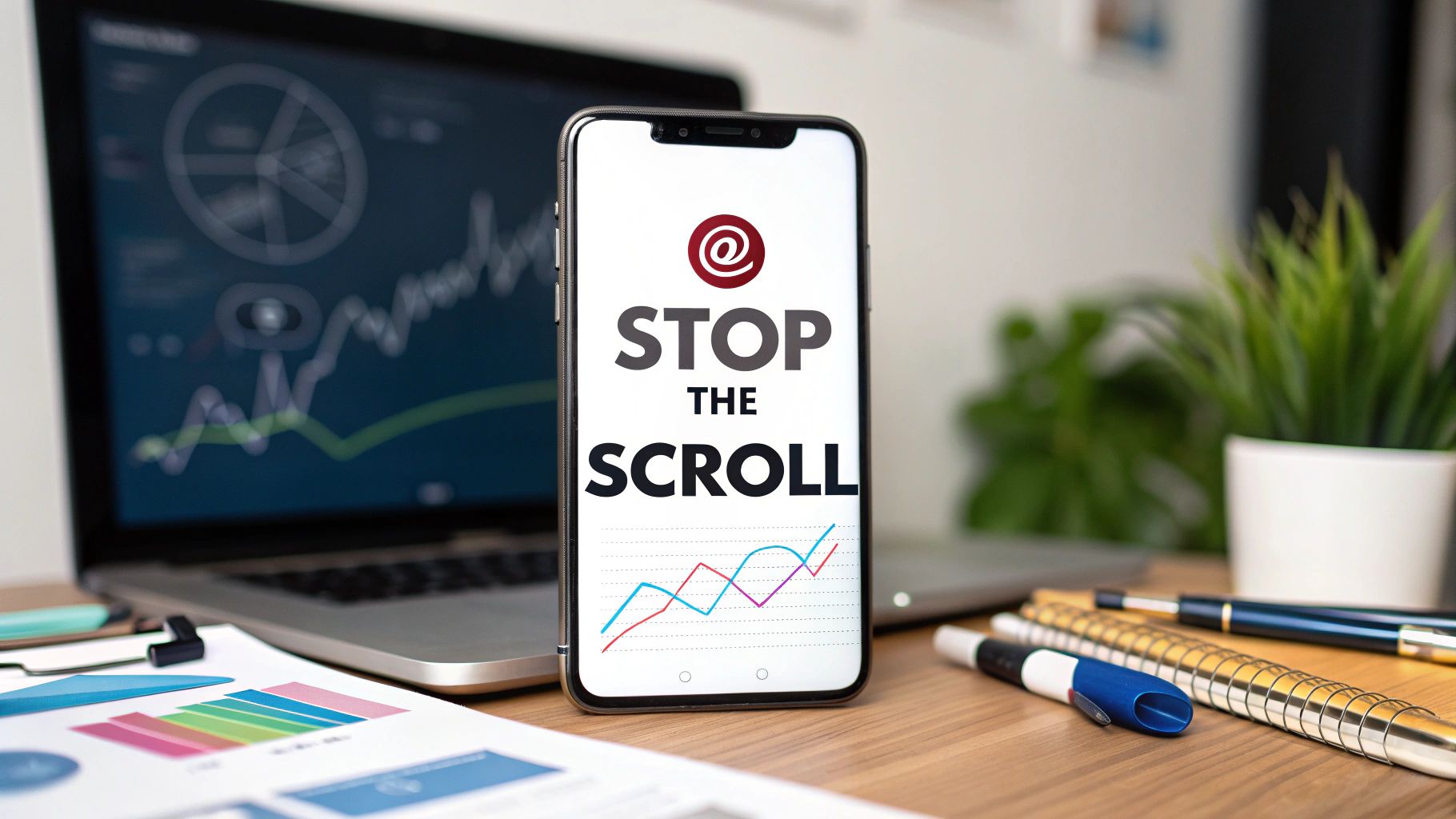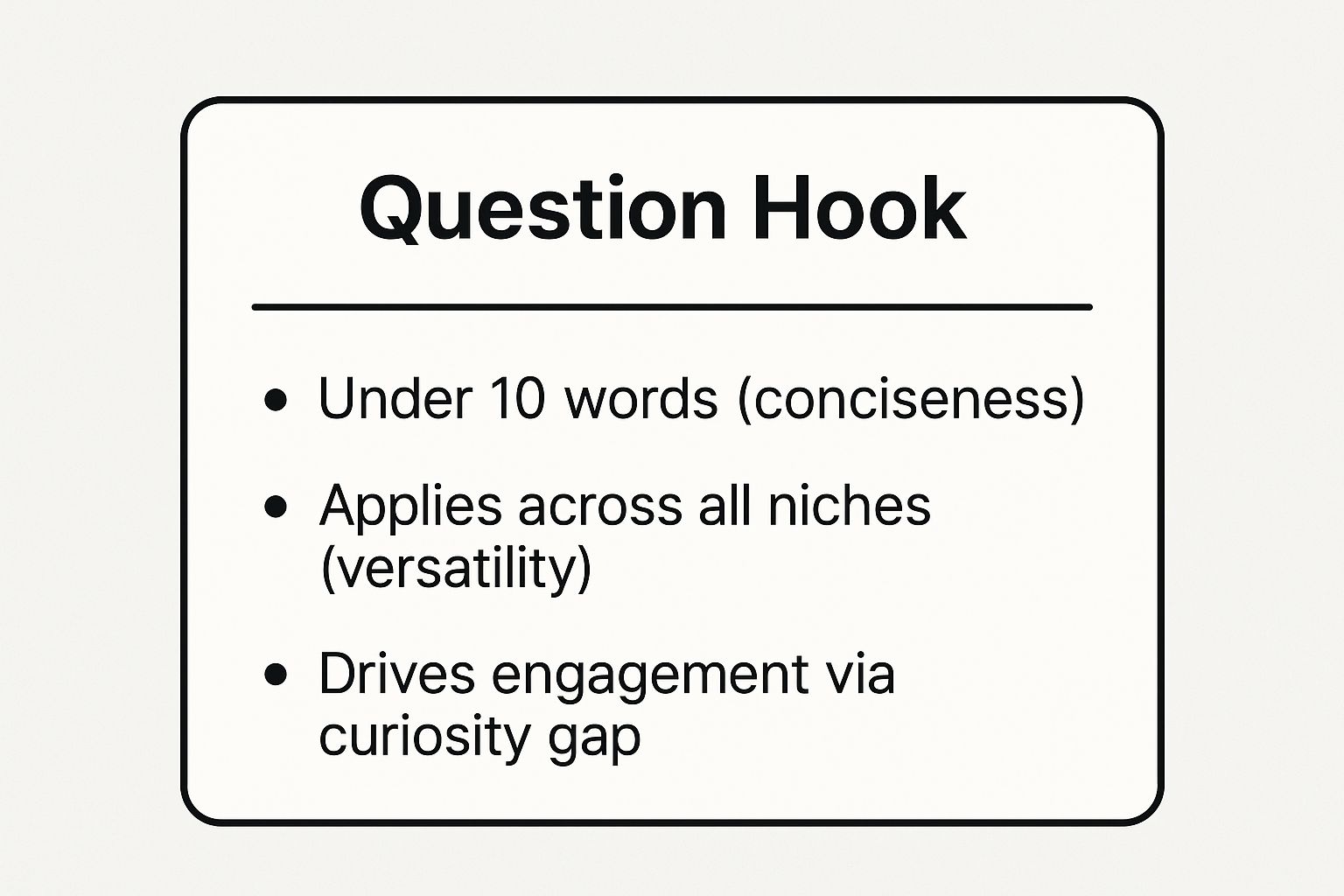
6 Powerful Hooks for Reels That Stop the Scroll in 2025
Discover 6 powerful hooks for reels that grab attention instantly. Learn expert strategies and get actionable examples to make your content go viral.
In the world of short-form video, the first three seconds of your Reel are a critical battleground for attention. A weak opening means viewers swipe away before they ever hear your message, while a powerful hook stops them in their tracks, creating instant curiosity and engagement. Getting this part right is no longer a suggestion; it's a requirement for growth. Without a compelling start, even the most valuable content goes unseen, and your efforts are wasted.
This article provides a strategic blueprint for capturing and holding audience attention. We will move beyond generic advice to dissect the six most effective types of hooks for Reels: the Question, the Shocking Statement, the Story, the Problem-Solution, the List, and the Contradiction. For each one, you'll get a deep dive into the psychology of why it works, complete with niche-specific examples and actionable takeaways you can implement immediately.
Mastering these techniques is the first step in turning passive scrollers into engaged followers and, ultimately, loyal customers. You will learn not just what to say, but how to say it to maximize impact from the very first frame. Let's get started.
1. Question Hook
Kicking off our list of powerful hooks for Reels is a timeless classic: the Question Hook. This technique immediately grabs a viewer's attention by posing a direct, compelling question in the first three seconds. It works by creating what psychologists call a "curiosity gap," an irresistible mental itch that makes viewers feel compelled to stay for the answer.
Instead of passively receiving information, the viewer is actively engaged, mentally searching for the solution you're about to provide. This is why questions like, "Why do 90% of people fail at this?" or "What's the biggest mistake you're making with your morning routine?" are so effective. They imply the viewer might be making a common error and offer a clear path to correction. This method is a favorite among thought leaders like Gary Vaynerchuk and Alex Hormozi because it’s direct, efficient, and immediately establishes value.
Strategic Breakdown
The power of the Question Hook lies in its psychological framing. It instantly shifts the dynamic from a one-way broadcast to a two-way conversation, even if the viewer's side is silent. A well-crafted question makes your audience feel seen and understood.
Key Tactic: Frame your question around a common pain point or a surprising statistic relevant to your niche. This creates an immediate connection and positions your content as the solution. For instance, a fitness coach could ask, "Are you making this one mistake in your squat that's killing your gains?" This is far more effective than a generic statement.
This infographic summarizes the core principles that make the Question Hook so effective across different platforms and industries.

As the visualization highlights, the conciseness and versatility of this hook make it a go-to strategy for any content creator. Its ability to create a curiosity gap is the primary driver of its success in boosting watch time.
Actionable Takeaways
To effectively implement this hook, follow these steps:
- Be Specific: Vague questions get scrolled past. "Have you ever wondered why your plants keep dying?" is much better than "Got questions about plants?"
- Promise a Clear Answer: Your video's purpose must be to directly answer the question you posed in the hook. Failing to deliver on this promise breaks trust with your audience.
- Use "You" and "Your": Address the viewer directly to make the question feel personal and urgent. For example, "Is your website losing customers because of this one simple error?"
2. Shocking Statement Hook
Next up is one of the most powerful, yet delicate, hooks for Reels: the Shocking Statement Hook. This technique opens with a bold, surprising, or controversial claim that instantly disrupts a user's passive scrolling. It works by creating cognitive dissonance, a mental discomfort that arises from holding two or more contradictory beliefs, which compels the viewer to stay and find out how you will justify your audacious claim.

Statements like, "Your morning routine is actually ruining your day," or "Everything you know about dieting is wrong," are designed to stop thumbs in their tracks. This method challenges conventional wisdom and positions you as an authority with inside knowledge. It’s a favorite tactic of influential marketers like Russell Brunson and Tai Lopez because it immediately frames the content as must-see information that goes against the grain. Learn more about the psychology behind this type of social media hook on Viewprinter.tech.
Strategic Breakdown
The effectiveness of the Shocking Statement Hook is rooted in its ability to defy expectations. In a sea of repetitive content, a statement that contradicts a widely held belief acts as a powerful pattern interrupt. This creates an immediate need for clarification and validation in the viewer's mind.
Key Tactic: Identify a common myth, a 'sacred cow', or a universally accepted 'best practice' in your niche and challenge it directly. The key is to be provocative without being misleading. For instance, a finance expert might say, "Saving your money in a bank account is the fastest way to go broke." This is far more intriguing than "Learn about inflation."
This hook positions your video not just as helpful content, but as a critical revelation. The immediate goal is to make the viewer think, "Wait, what? I have to hear this." This initial jolt of surprise is crucial for capturing attention in the noisy environment of social media feeds.
Actionable Takeaways
To use this powerful hook without damaging your credibility, follow these critical steps:
- Substantiate Your Claim: This is the most important rule. If you make a shocking statement, you must back it up with credible data, a logical argument, or a compelling case study within the Reel. Failure to do so will destroy trust.
- Focus on Industry Myths: Every industry has its own set of outdated beliefs or misconceptions. Target these to demonstrate your deep expertise and provide genuine value to a knowledgeable audience.
- Use Confident Language: Deliver your statement with conviction. Your tone and body language must match the boldness of your words to be believable. Hesitation will undermine the hook's impact.
3. Story Hook
Next on our list of essential hooks for Reels is the deeply engaging Story Hook. This technique leverages the fundamental human love for narrative by starting your video with the most compelling part of a personal anecdote or story. It immediately draws viewers in, creating an emotional connection that makes them want to see how the story unfolds.
This hook works by tapping into our innate curiosity and empathy. When we hear a story beginning with a moment of high drama, vulnerability, or transformation, like "Three years ago, I was sleeping on my friend's couch..." or "The day I got fired was the best day of my life," our brains are wired to stick around for the resolution. This method has been masterfully used by inspirational figures like Tony Robbins and business mentors such as Amy Porterfield to build trust and deliver powerful messages that resonate on a personal level.

Unlike other hooks that rely on pure shock or curiosity, the Story Hook builds an immediate bridge of relatability between you and your audience. It makes your content feel less like marketing and more like a genuine conversation, which is incredibly effective for building a loyal community.
Strategic Breakdown
The Story Hook's effectiveness comes from its ability to bypass the viewer's analytical brain and speak directly to their emotions. A well-told story creates a shared experience, making the lesson or message at the end far more memorable and impactful. It transforms your content from a simple tip into a powerful lesson wrapped in a human experience.
Key Tactic: Start your story in media res (in the middle of the action). Don't begin with "Let me tell you a story." Instead, jump directly to the peak moment of conflict, vulnerability, or change. A line like, "I almost quit my business until this one thing happened," is far more compelling than a slow, chronological buildup.
This approach creates immediate intrigue and signals to the viewer that your Reel contains a valuable, hard-won insight. By sharing a moment of struggle or a pivotal turning point, you humanize your brand and make your expertise feel more authentic and accessible.
Actionable Takeaways
To use the Story Hook effectively in your Reels, follow these guidelines:
- Focus on Transformation: The best story hooks hint at a significant change. Frame your story around a clear before-and-after, whether it's in business, mindset, or skill.
- Keep it Relevant: Your story must be a direct pathway to the core message or value proposition of your Reel. If the anecdote doesn't connect to the takeaway, it will feel disjointed and lose its impact.
- Use Vivid Details: Make your story come alive with specific sensory details. Instead of saying "I was broke," try "My bank account had $17, and I was eating ramen for the fifth night in a row." Specificity makes the story believable and relatable.
4. Problem-Solution Hook
One of the most direct and effective hooks for Reels is the Problem-Solution Hook. This approach immediately identifies a common and frustrating pain point your target audience experiences and instantly promises a clear, actionable solution. It works by creating immediate relevance; when a viewer hears their exact struggle articulated, they feel seen and are compelled to watch for the promised resolution.
This hook cuts through the noise by addressing a felt need. Instead of generic advice, you’re offering a specific remedy to a known problem. This is why hooks like, "Tired of your hair looking flat? Here's the 30-second fix" or "Struggling with productivity? These 3 apps will change everything" perform so well. They validate the viewer's frustration while positioning the content as an immediate, high-value answer. This method is a cornerstone for experts like Neil Patel and James Clear, who build authority by consistently solving their audience's problems.

Strategic Breakdown
The power of the Problem-Solution Hook lies in its psychological efficiency. It taps directly into the human desire for relief and improvement, creating an instant bond between the creator and the viewer. A well-framed problem makes the audience feel understood on a personal level.
Key Tactic: Start your Reel by stating the problem using emotional or sensory language that your audience uses themselves. Then, immediately pivot to the solution, quantifying the benefit whenever possible (e.g., "in 30 seconds," "with just 2 ingredients"). For example, a chef might say, "Sick of bland, boring chicken? This one marinade will change the game." This transforms a simple recipe into a must-have solution.
This video demonstrates how framing content around solving a specific issue can significantly boost engagement and establish credibility.
As the video highlights, this hook is fundamental to creating content that doesn't just entertain but serves a real purpose for the viewer. Mastering this hook is a key step in developing a content strategy that can go viral. To delve deeper into this, explore our guide on how to create viral content on viewprinter.tech.
Actionable Takeaways
To effectively implement the Problem-Solution Hook, follow these steps:
- Know Your Audience's Pain: Conduct research through surveys, comment sections, and forums to identify the most pressing and frequently mentioned problems in your niche.
- Be Hyper-Specific: Don't say "Bad at marketing?" Instead, try "Are your Facebook ads getting clicks but no sales?" Specificity increases relevance and stopping power.
- Deliver the Promised Solution: Your entire video must be dedicated to solving the problem you introduced. Failing to provide a clear, valuable answer will damage your credibility and lose followers.
5. List/Number Hook
Next on our lineup of compelling hooks for Reels is the highly structured and viewer-friendly List/Number Hook. This technique immediately sets clear expectations by promising a specific quantity of tips, secrets, reasons, or steps. It works by giving the viewer a mental roadmap, letting them know exactly what they're going to get and how the information will be organized.
This hook taps into our brain's preference for order and predictability. When viewers see a title like, "5 signs you're ready to start your own business" or "3 mistakes killing your Instagram growth," they understand the video's structure from the first second. This clarity reduces mental friction and makes the content feel digestible and actionable, increasing the likelihood that they'll stick around to see all the points. This method was perfected in the blogosphere by giants like BuzzFeed and HubSpot and has been seamlessly adapted for short-form video.
Strategic Breakdown
The power of the List/Number Hook is its promise of finite, high-value information. Unlike a vague promise, a number provides a concrete structure that viewers can easily follow. It turns a potentially overwhelming topic into a simple, step-by-step format, which is perfect for the fast-paced nature of Reels.
Key Tactic: Use odd numbers like 3, 5, or 7. Psychological studies suggest that odd numbers feel more authentic and less manufactured than even numbers, which can make your list seem more credible. For example, "7 productivity hacks that changed my life" often performs better than "6 productivity hacks."
This approach is a cornerstone of effective content marketing, as it packages expertise into a format that is easy to consume and share. For those looking to dive deeper into structuring their content for maximum impact, you can learn more about these content marketing best practices. This hook is one of the most reliable hooks for Reels because it delivers on a clear promise.
Actionable Takeaways
To make the List/Number Hook work for your content, follow these guidelines:
- Focus on Brevity: Keep your list concise. For Reels, numbers between 3 and 10 work best. Anything higher can feel intimidating and may cause viewers to drop off before the end.
- Deliver on Every Point: Each item in your list must provide genuine value. If even one point is weak, you risk losing credibility and future viewership. Make sure each tip or secret is a standalone piece of quality information.
- Use Visual Cues: Reinforce the number on screen. Use text overlays or hold up your fingers to count down or up as you present each point. This visual reinforcement helps keep viewers engaged and tracks their progress through the list.
6. Contradiction Hook
Next on our list of potent hooks for Reels is the Contradiction Hook, a powerful technique that instantly disrupts a viewer's expectations. This method works by presenting two opposing ideas or directly challenging a widely held belief. It creates a state of cognitive dissonance, a mental discomfort that makes viewers feel a strong urge to stay and see how you resolve the paradox.
Instead of presenting a straightforward fact, you introduce an idea that seems impossible or counterintuitive. This immediately flags your content as unique and worth investigating. This is why statements like, "I work only 4 hours a day but earn more than my friends in 9-to-5s," or "My worst business decision became my biggest success," are so effective. They break established patterns of thinking and promise a novel perspective. This approach is a hallmark of thought leaders like Tim Ferriss and Seth Godin, who built their brands on challenging the status quo.
Strategic Breakdown
The effectiveness of the Contradiction Hook is rooted in its ability to create immediate intrigue and position you as an expert with unique knowledge. By presenting a claim that goes against conventional wisdom, you imply that you possess a secret or a superior strategy that the viewer is missing out on. It's a bold move that, when executed correctly, establishes instant authority.
Key Tactic: Frame the contradiction around a common goal or frustration in your niche. Your claim should directly oppose the typical advice given to achieve that goal, creating a powerful "pattern interrupt" that stops the scroll. For instance, a marketing agency might say, "The less I posted on Instagram, the more my engagement grew." This directly challenges the "post more" mantra and promises a smarter, more efficient solution.
This hook doesn't just grab attention; it filters for a more engaged audience. Viewers who are genuinely interested in the topic will feel compelled to understand the "how" behind your paradoxical claim, leading to higher watch times and more meaningful interactions.
Actionable Takeaways
To leverage this hook for your Reels, follow these critical steps:
- Be Authentic: Your contradiction must be genuine. If you claim to "eat more and weigh less," you need to back it up with a real story, system, or evidence. Fabricated claims will quickly destroy your credibility.
- Deliver the Explanation: The entire purpose of the Reel must be to resolve the contradiction you presented. Clearly explain the logic, system, or context that makes your counterintuitive statement true. Don't leave your audience hanging.
- Focus on Industry-Specific Beliefs: Identify a common "truth" in your industry and challenge it. A tech entrepreneur could say, "We launched our app with zero marketing budget and hit 10,000 users." This is far more impactful than a generic contradiction.
6 Hook Types Comparison Guide
| Hook Type | Implementation Complexity 🔄 | Resource Requirements ⚡ | Expected Outcomes 📊 | Ideal Use Cases 💡 | Key Advantages ⭐ | |-----------------------|-----------------------------------|---------------------------------|---------------------------------------------------------|----------------------------------------------------|----------------------------------------------------| | Question Hook | Low 🔄 | Low ⚡ | High engagement; stimulates curiosity 📊 | Broad niches; conversational and interactive content | Easy to implement; builds connection; encourages interaction ⭐ | | Shocking Statement Hook | Medium-High 🔄 | Medium ⚡ | Strong attention grab; high engagement, shareability 📊 | Bold, controversial content; challenging beliefs | High stopping power; builds authority; memorable content ⭐ | | Story Hook | High 🔄 | Medium-High ⚡ | Deep emotional connection; memorable 📊 | Brand building; trust; emotional journeys | Builds strong bonds; highly shareable; broad appeal ⭐ | | Problem-Solution Hook | Medium 🔄 | Medium ⚡ | High relevance; trust building; actionable results 📊 | Educational, how-to, pain point addressing content | Clear value; encourages saves/shares; easy to structure ⭐ | | List/Number Hook | Low-Medium 🔄 | Low ⚡ | Clear, digestible content; anticipation 📊 | Educational; quick tips; structured information | Clear structure; highly shareable; easy to follow ⭐ | | Contradiction Hook | Medium-High 🔄 | Medium ⚡ | Curiosity; thought leadership; engagement 📊 | Challenging norms; thought-provoking content | Creates psychological pull; memorable; encourages discussion ⭐ |
From Hook to Conversion: Putting It All Together
We've explored six foundational categories of hooks for reels, from the curiosity-sparking Question Hook to the authoritative List Hook and the pattern-interrupting Contradiction Hook. Each framework is a powerful tool designed to accomplish one critical mission: to stop the endless scroll and earn your viewer's attention in under three seconds. But as we've seen, a hook is not an isolated element; it's the first link in a chain that leads a viewer from casual interest to genuine engagement and, ultimately, to conversion.
Mastering these templates is about more than just copying and pasting text. It's about understanding the underlying psychology of why each one works. A Shocking Statement hook grabs attention through surprise, while a Story Hook builds an immediate emotional connection. The key is to see these not as rigid rules but as flexible starting points for your creative strategy. The true power lies in aligning the right hook with the right piece of content for the right audience.
The Strategic Value of a Strong Opening
A powerful opening does more than just boost view counts. It fundamentally changes how your audience perceives your brand and content.
- It Builds Authority: Using hooks that demonstrate expertise, like the Problem-Solution or List formats, positions you as a go-to resource in your niche. You aren't just entertaining; you are providing tangible value.
- It Filters Your Audience: A well-crafted hook, especially one that calls out a specific pain point or desire, acts as a filter. It instantly signals to your ideal customer or follower that this content is specifically for them, leading to higher-quality engagement from a more qualified audience.
- It Maximizes Content ROI: You invest significant time and resources into creating valuable video content. A weak hook means that investment is wasted. By optimizing the first three seconds, you ensure your core message actually gets seen, dramatically increasing the return on your creative efforts.
Your Action Plan for Mastering Reel Hooks
Knowledge without action is just trivia. To turn the insights from this article into measurable results, you need a clear, systematic plan. Don't let this be just another article you read; let it be the one that transforms your approach to short-form video.
Your immediate next step is to move from learning to testing. Don't guess what will work for your audience. Find out for sure.
- Choose One Core Idea: Select a single piece of advice, a product feature, or a story you want to share in a Reel.
- Craft Two Different Hooks: Write two distinct openers for that same core idea using the frameworks we've covered. For example, test a Question Hook ("Are you making this mistake with your content?") against a Shocking Statement Hook ("Your content strategy is probably failing because of this one mistake.").
- Analyze and Iterate: Post both versions (ideally a day or two apart) and meticulously track the analytics. Pay close attention to watch time and audience retention. Which hook held viewers longer? This data-driven feedback is the key to refining your strategy and understanding what truly resonates with your specific audience. Systematically testing your hooks for reels is the single most effective way to turn your content creation from a game of chance into a reliable engine for growth.
Ready to accelerate your testing process and generate endless hook ideas without creative burnout? ViewPrinter can help you create dozens of hook variations with AI and produce high-quality, avatar-led videos to test them at scale. Stop guessing and start creating data-backed Reels that convert by visiting ViewPrinter today.